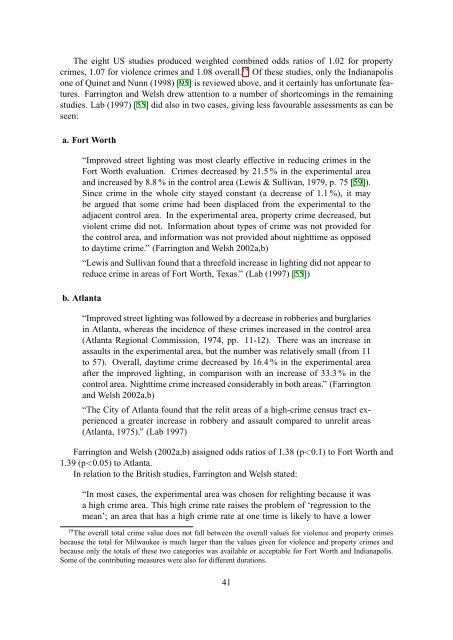outdoor lighting and crime, part 1 - Astronomical Society of Victoria
outdoor lighting and crime, part 1 - Astronomical Society of Victoria
outdoor lighting and crime, part 1 - Astronomical Society of Victoria
Create successful ePaper yourself
Turn your PDF publications into a flip-book with our unique Google optimized e-Paper software.
The eight US studies produced weighted combined odds ratios <strong>of</strong> 1.02 for property<br />
<strong>crime</strong>s, 1.07 for violence <strong>crime</strong>s <strong>and</strong> 1.08 overall. 19 Of these studies, only the Indianapolis<br />
one <strong>of</strong> Quinet <strong>and</strong> Nunn (1998) [95] is reviewed above, <strong>and</strong> it certainly has unfortunate features.<br />
Farrington <strong>and</strong> Welsh drew attention to a number <strong>of</strong> shortcomings in the remaining<br />
studies. Lab (1997) [55] did also in two cases, giving less favourable assessments as can be<br />
seen:<br />
a. Fort Worth<br />
“Improved street <strong>lighting</strong> was most clearly effective in reducing <strong>crime</strong>s in the<br />
Fort Worth evaluation. Crimes decreased by 21.5 % in the experimental area<br />
<strong>and</strong> increased by 8.8 % in the control area (Lewis & Sullivan, 1979, p. 75 [59]).<br />
Since <strong>crime</strong> in the whole city stayed constant (a decrease <strong>of</strong> 1.1 %), it may<br />
be argued that some <strong>crime</strong> had been displaced from the experimental to the<br />
adjacent control area. In the experimental area, property <strong>crime</strong> decreased, but<br />
violent <strong>crime</strong> did not. Information about types <strong>of</strong> <strong>crime</strong> was not provided for<br />
the control area, <strong>and</strong> information was not provided about nighttime as opposed<br />
to daytime <strong>crime</strong>.” (Farrington <strong>and</strong> Welsh 2002a,b)<br />
“Lewis <strong>and</strong> Sullivan found that a threefold increase in <strong>lighting</strong> did not appear to<br />
reduce <strong>crime</strong> in areas <strong>of</strong> Fort Worth, Texas.” (Lab (1997) [55])<br />
b. Atlanta<br />
“Improved street <strong>lighting</strong> was followed by a decrease in robberies <strong>and</strong> burglaries<br />
in Atlanta, whereas the incidence <strong>of</strong> these <strong>crime</strong>s increased in the control area<br />
(Atlanta Regional Commission, 1974, pp. 11-12). There was an increase in<br />
assaults in the experimental area, but the number was relatively small (from 11<br />
to 57). Overall, daytime <strong>crime</strong> decreased by 16.4 % in the experimental area<br />
after the improved <strong>lighting</strong>, in comparison with an increase <strong>of</strong> 33.3 % in the<br />
control area. Nighttime <strong>crime</strong> increased considerably in both areas.” (Farrington<br />
<strong>and</strong> Welsh 2002a,b)<br />
“The City <strong>of</strong> Atlanta found that the relit areas <strong>of</strong> a high-<strong>crime</strong> census tract experienced<br />
a greater increase in robbery <strong>and</strong> assault compared to unrelit areas<br />
(Atlanta, 1975).” (Lab 1997)<br />
Farrington <strong>and</strong> Welsh (2002a,b) assigned odds ratios <strong>of</strong> 1.38 (p
















